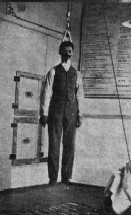Mad Science Experiments
Amazing Stories from the History of Science
1894 Low-flying Cats (book p. 46)
|
Physiologist und inventor Étienne-Jules Marey captured a falling cat on film - and soon after dogs, rabbits, apes and a “small, plump guinea pig” - in order to find our how they manage to land paws first. Below the fascinating original footage. Falling Cat 1 Falling Rabbit 1 Falling Rabbit 3 Falling Rabbit 4 |
|
1902 Pavlov Only Rings Once (book p. 63)
Classical Conditioning: The Basics
Pavlovs conditioning even made it into a Disney film.
Does Pavlov Ring a Bell
1920 Putting the Wind Up Little Albert (Book p.79)
If Albert is still alive he’d be in his eighties. But in all probability he wouldn’t even be aware that he is the famous ‘Little Albert’ whose scream is familiar to every student of psychology. He was just nine months old when the film was made, in which Psychologist John Watson conditioned him to fear a rat. Perhaps it might still be one of his distinguishing features today – a pronounced fear of white rats.
Little Albert
1928 The Living Dog’s Head (book p. 96)
With this footage the russians wanted to prove their advance in surgical techniques. The popular science magazine "Science and Invention" enthused: “Do not even the widest imaginations of our modern science fiction writers pale into insignificance because of the steady advance and progress of scientific research?” Look for yourself - not for the faintharted! (for the whole movie click here).
